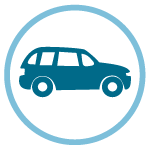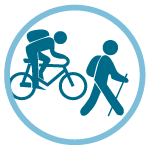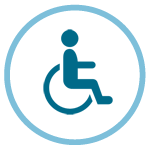Welcome
Water is a valuable and scarce resource, it is the key of life and a basic natural good in our present and essential for the future.
The province of Alicante has always been closely linked to this resource of great value. For over 30 years the Diputación de Alicante (Provincial Government) and the Instituto Geológico y Minero de España IGME (Spanish Geological Survey) have joined their effords to improve the knowledge about water in the province.
As fruit of this extensive work, it has been produced a large number of technical studies that have improved the knowledge, han permitido el mejor conocimiento, exploitation and management of the provincial water resources, specially in those of underground origin. Now we want to transmit part of this knowledge in a playful and adapted to a wide public lover nature, in the form of a varied proposal of routes and excursions through our territory.
We hope that these Blue Routes allow to enjoy both the Alicante and the millions of people who visit us of the great heritage that is the water in our province.
What are the Blue Routes?
The Blue Routes are a proposal for the traveller and hiker that will allow you to discover the richness of the province of Alicante of corners and landscapes where water is the protagonist.
The Blue Routes are organized in two field guides, which are complemented with this web page and a app for mobile devices. The first of the guides, Blue Routes through the Province of Alicante, proposes six routes that connect places where water is the protagonist of note: rivers, springs and wetlands.
The second, Blue Routes through the Hydrogeological Heritage of Alicante, proposes ten routes through water landscapes in all the regions of the province, which link elements of the provincial hydrogeological heritage. These heritage elements correspond to the so-called Places of Hydrogeological Interest (PHIs), which are forms, elements and/or natural structures originating from geological processes in which water is an essential agent.
They are structured as extensive trails that cover locations of especial interest, and some of them propose excursions or microroutes of different difficulty and duration for walking, cycling or off-road vehicles.
Plan your route
The Blue Routes through the province of Alicante aim to bring hydrogeological knowledge and hydraulic heritage to hikers.
Each of them includes a series of Enclaves or Points of Interest carefully chosen for their hydrological interest, beauty and accessibility.
Access to routes and mobility

By car
The Routes have been designed to be driven by car.

By bicycle or on foot
However, in some of these Enclaves we propose Excursions of different time and difficulty, to enjoy both on foot and by bicycle, and that link Points of Interest.

Disabled access
In the Natural Parks of Las Lagunas de La Mata y Torrevieja and El Hondo, a section of the excursion has been chosen for people with reduced mobility, including wheelchairs.
Calculate the time of each route
The total time of each Route has been obtained suming the car time it takes to go from one Enclave to another, with the appropriate speed to each track.
It is not included in this total time that the hiker decides to stay in each of the Enclaves or tour the Excursions. Likewise, in the total time of the Excursiones, the time that each hiker decides to stay at each point has not been considered.
To be considered for safety
The Routes run along roads, paths, paths, or river courses, which we have traveled on numerous occasions before proceeding to the edition.
No danger has been observed that could exist carrying it out as indicated in the text. In any case, hiking and mountain routes, however simple they may seem, can be risky if the appropriate preventive measures are not taken.
Tips / you should know
Make a correct route planning, times, difficulties…, supported by the documentation and planimetry attached to the routes.
Before the excursion
- Informate de las weather conditions and its possible evolution. Bad weather in the bush is dangerous and causes a large number of accidents. This is of the utmost importance in these Blue Routes, as some of the routes are made by ravines and canyons that in the event of torrential rains could flood in a dangerous way. Keep in mind that the rains may be falling higher, without you knowing what comes with the flooding of the flow rate.
- We will always go to accompanied on the excursions, never alone.
- Carry always a small first-aid kit.
- Carry sun protection (cream, glasses and cap).
- Informato your family and friends that you plan to make a Routes and where.
During the excursion
- Do not leave the group.
- Do not make any unnecessary efforts.
- Rest when you feel tired.
- Drink water often.
- If you are cold, don’t stop walking. Drink and eat while on the move.
- Save forces for the return. Don’t ever be in a hurry. Do not undertake companies for which you do not have the appropriate physical and technical preparation and equipment. The best safety measure is to apply the common sense.
- Talk with people about the places you visit and don’t disregard their opinions and advice; they are the ones who know most about the terrain to be visited and their possible difficulties. Popular culture is of great importance and wisdom; do not undervalue it.
The Routes coincide in some points with small trails (PR). These are trails, of less than 50 km, which can be done in one or two days. They are marked with a white and a yellow band.
Protect the environment
- If you go for a walk with dog, tighten the dog so that it does not disturb animals or other hikers.
- Be respectful with the environment. Keep the environment natural surrounding environment clean. Do not leave papers, cans, or any other type of waste. Store them in the backpack and put them in the closest container.
- Do not light fire and if you smoke, do not throw cigarette butts.
- Respeta always the natural environment, we will not leave a mark on our path. Some species have left these habitats because of the scant attention paid to these councils. These are irreparable losses.
The historical and archaeological heritage is also protected by law, although it has traditionally been plundered or destroyed without compassion. This has also led to attacks whose consequences are definitive, erasing traces of history that will no longer serve to identify our past and our cultural identity.
Protect people
In case of accident:
- Stay calm and apply first aid.
- Think about the nearest aid place (refuge, telephone…) and how to reach it.
- If possible, do not leave the injured alone.
- If not, reference the point to indicate it to the rescue teams. Once the warning has been given, you must remain perfectly located in case it is necessary to collaborate in the rescue.
- If you need help, visit us personally by radio or telephone. A mobile phone is a great aid.



